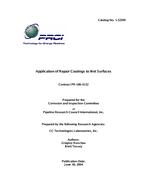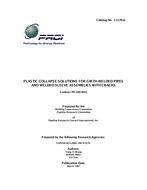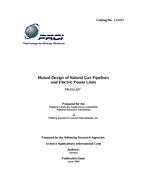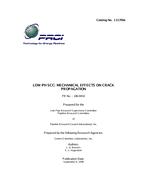Provide PDF Format
PRCI PR-186-03132
- Application of Repair Coatings to Wet Surfaces
- Report / Survey by Pipeline Research Council International, 06/24/2004
- Publisher: PRCI
$38.00$75.00
L52209e
CC Technologies
Need: The field application of pipeline repair and rehabilitation coatings can be greatly dependent upon the ambient conditions on the day of the scheduled repair. In some cases, such as the application of FBE at girth welds, temporary shelters can be built over the girth weld area to protect pipe from the elements. However, for the majority of pipeline applications, coatings must be applied to a pipe surface that is not optimized for coating application. Specifically, pipelines which are in service during the repair coating operation will be at the temperature of the product flowing through them regardless of the ambient temperature. This poses a very large problem when the temperature of the pipeline is below the dew point of the ambient air, because condensation will occur continuously on the pipe surface.
Result: The objective of this work was to determine the performance implications of applying pipeline repair coatings to wet or damp surfaces. Six liquid repair coatings were applied to steel substrates with varying degrees of surface wetness. Three coatings were standard epoxies; three were specially formulated for wet surface tolerance. The coatings were tested for cathodic disbondment resistance, mechanical strength, and how each coating interacts with water during curing. FTIR and DSC analysis of each coating when mixed and cured in wet conditions (water added to the mix) showed no evidence of water interacting with the coating and changing the chemical structure or the chemical properties. Thus it was concluded that the wet surface tolerant coatings, while manufacturers may claim that they were formulated to absorb and accommodate water, in reality just have a better ability to displace water than standard repair coatings.
Benefit: It was discovered that the only real effect on performance was noticed at saturated moisture levels; small amounts of condensation on the surface had no noticeable effect. For the coatings which were not wet surface tolerant, it was obvious that pockets of water were trapped under the coatings when applied over saturated surfaces, so there were many areas of localized disbondment. The coatings which were more surface-tolerant were able to displace the water and did not trap water in pockets, so their performance was improved and certainly more uniform.
CC Technologies
Need: The field application of pipeline repair and rehabilitation coatings can be greatly dependent upon the ambient conditions on the day of the scheduled repair. In some cases, such as the application of FBE at girth welds, temporary shelters can be built over the girth weld area to protect pipe from the elements. However, for the majority of pipeline applications, coatings must be applied to a pipe surface that is not optimized for coating application. Specifically, pipelines which are in service during the repair coating operation will be at the temperature of the product flowing through them regardless of the ambient temperature. This poses a very large problem when the temperature of the pipeline is below the dew point of the ambient air, because condensation will occur continuously on the pipe surface.
Result: The objective of this work was to determine the performance implications of applying pipeline repair coatings to wet or damp surfaces. Six liquid repair coatings were applied to steel substrates with varying degrees of surface wetness. Three coatings were standard epoxies; three were specially formulated for wet surface tolerance. The coatings were tested for cathodic disbondment resistance, mechanical strength, and how each coating interacts with water during curing. FTIR and DSC analysis of each coating when mixed and cured in wet conditions (water added to the mix) showed no evidence of water interacting with the coating and changing the chemical structure or the chemical properties. Thus it was concluded that the wet surface tolerant coatings, while manufacturers may claim that they were formulated to absorb and accommodate water, in reality just have a better ability to displace water than standard repair coatings.
Benefit: It was discovered that the only real effect on performance was noticed at saturated moisture levels; small amounts of condensation on the surface had no noticeable effect. For the coatings which were not wet surface tolerant, it was obvious that pockets of water were trapped under the coatings when applied over saturated surfaces, so there were many areas of localized disbondment. The coatings which were more surface-tolerant were able to displace the water and did not trap water in pockets, so their performance was improved and certainly more uniform.
Related Products
PRCI Report Of Investigations 5836
Effect Of Methyltrichlorosilane On Permeability Of Sandstone Cores To Gas And Water..
$6.00 $12.00





